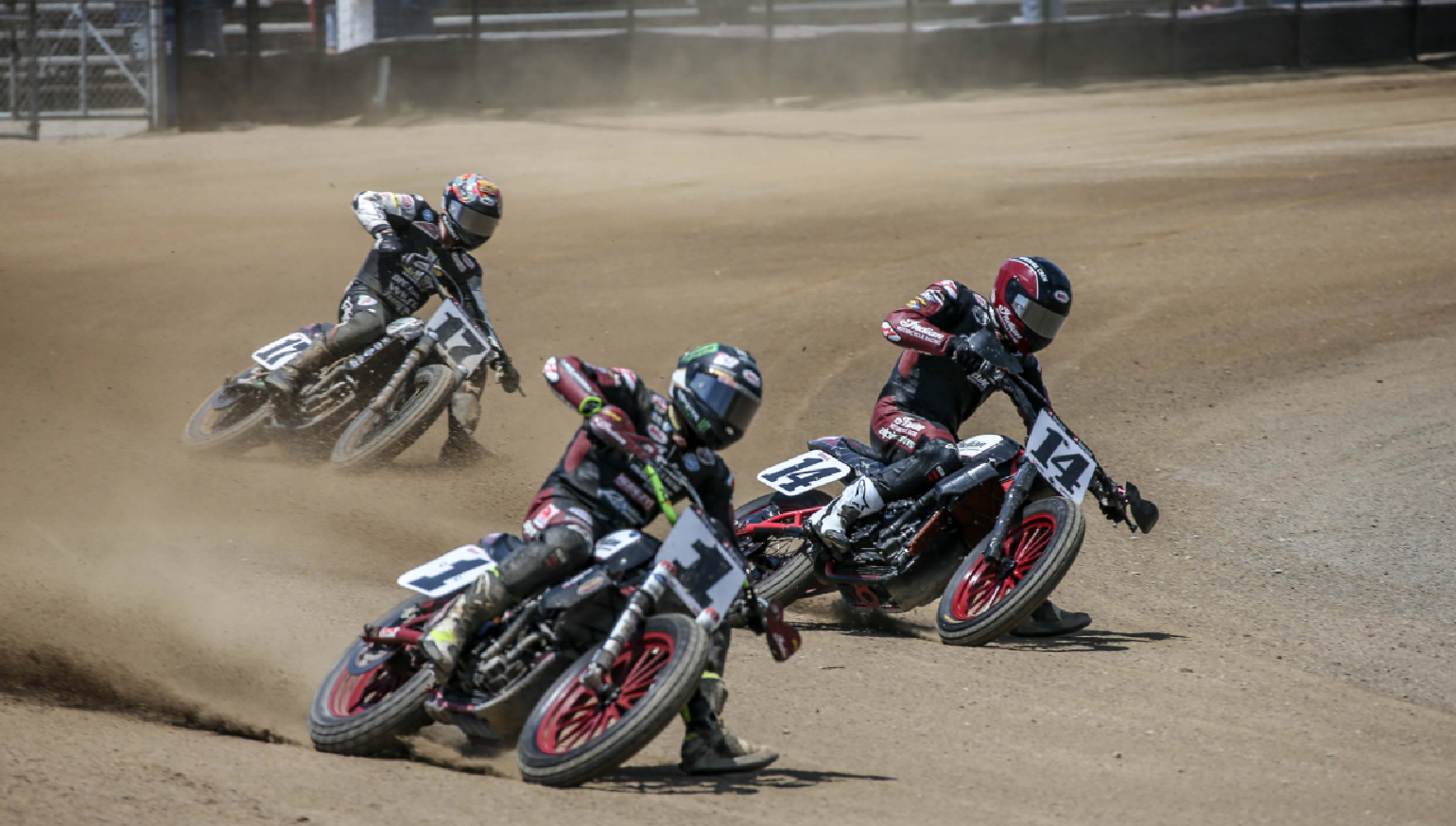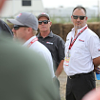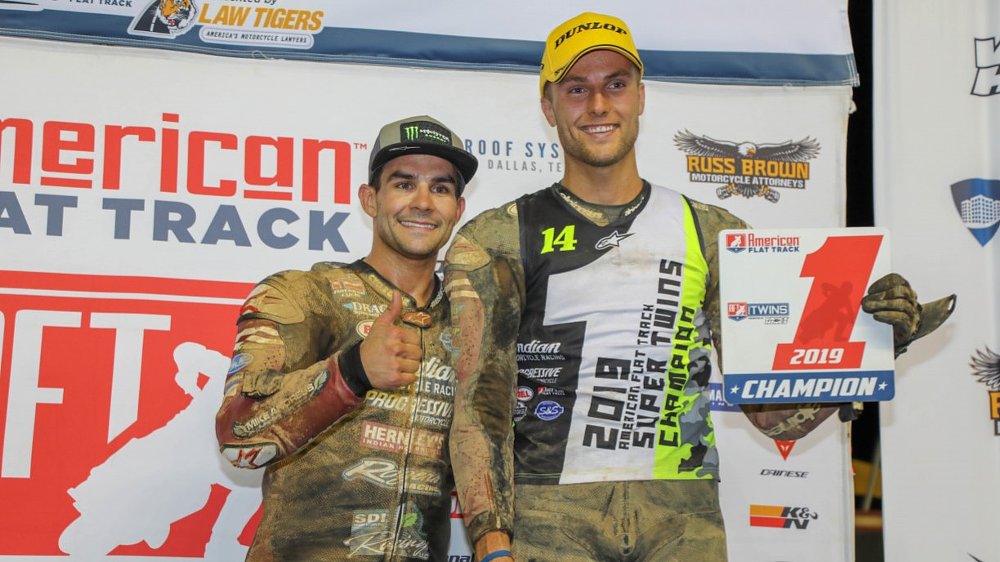Back in March, American Flat Track teams and racers had unloaded bikes and set up awnings in the Daytona paddock and were about to hold the first race of the 2020 season when the president declared an official state of emergency. Everyone packed back up; riders, mechanics, and teams returned to their home bases.
What was that, about two years ago? Or does it just feel that long?
After a four-month break and at least one false start, an abbreviated 2020 AFT season will finally get underway this weekend in Florida. (Yes, that Florida, the one that hit 15,000 new coronavirus cases in a single day last week.) American Flat Track has published a 40-page Event Operations Protocol which is intended to minimize the risks of turning AFT races into “super-spreader” events. It put a shorter COVID-10 safety FAQ sheet on its web site for fans. They've even added AFT logo face masks to the online store.
I talked to AFT CEO Michael Lock about what it takes to put on a racing series during a resurging pandemic (interview below), but first let's look at what to expect on the track.
Racers want to race
Let’s face it, if they were risk-averse, they wouldn’t have become professional motorcycle racers. So of course they want to race, as you can tell from their Instagram posts. (And, if you’re going to bang handlebars at more than 100 mph, the additional risk of COVID-19 is trivial.)
Indian Motorcycle Wrecking Crew rider Briar Bauman will defend his #1 plate. He earned it in the AFT Twins class, but will race in AFT SuperTwins presented by Vance & Hines, which is now the marquee class for factory bikes. Realistically, Briar’s stiffest competition will come from his Indian factory teammates; his brother, Bronson, came on stronger and stronger as the 2019 season progressed, and Jared Mees will likely prove as determined as ever.
For the last few years, the AFT Twins class podium has been an Indian reserve, and it’s hard to imagine that changing. But the team many will be watching is a reconfigured and hopefully reenergized Harley-Davidson factory squad.
The factory Harley-Davidson effort has underwhelmed since The Motor Company switched from the nearly 50-year-old XR750 motor to race motors based on the water-cooled Street 750 mill. Over three dismal seasons from 2017 through 2019, I spoke to veteran owners and tuners who told me the problem wasn’t the basic architecture of the XG750, it was Vance & Hines’ approach to preparing it. For 2020, Harley’s finally made a change. The factory XG750R Rev X motorcycles will still race out of Vance & Hines’ Brownsburg shop on Indianapolis’ west side, but the team will now be supervised by Ricky Howerton.
The factory team will platoon a veteran, Bryan Smith, with two up-and-coming young guys, Jarod Vanderkooi and Daulton Gauthier. Smith has won races on both Kawasakis and Indians prepared by Howerton. If anyone can find a few tenths in those Harleys, it’s those guys.
“We’re ready!” Howerton texted me as he was getting packed to head to Florida. It would be good for the sport if they can regularly pose a threat to the Indian FTR750s. Let’s also hope that J.D. Beach can find a way past a few Indians — although a schedule with only one TT and a bunch of half-miles won’t exactly play to the strengths of his Estenson Racing Yamaha MT-07 DT.
Supporting classes: Roof Systems AFT Singles and AFT Production Twins
Red Bull KTM’s Shayna Texter will be a sentimental favorite in the AFT Singles class, but she may be another racer who is hurt by an abbreviated schedule short on Mile tracks, where strategic drafting (and low drag) serve her well.
Mikey Rush, now racing for Tim Estenson’s “superteam” is a very talented racer on what should be a well prepped Yamaha YZ450F. Estenson’s also running Dallas Daniels in AFT Singles, and he’s got a bright future.
Last, but by no means least, Richie Morris Racing lost Rush but signed Henry Wiles to replace him. That raised a few eyebrows; Wiles spent the last three seasons in AFT Twins, and finished second overall in 2018. Racing in the Singles class this year could be seen as a step down, or a strategic retreat into a class that, for whatever reason, really suits him. Wiles was Grand National Singles champion in 2009 and ’10, and has a total of 26 National wins on 450s, making him by far the winningest active rider in the class.
Cory Texter will defend his title in the Production Twins class on a Yamaha MT-07 with backing from Roof Systems. Other strong contenders will be Ryan Varnes on a Kawasaki, and Chad Cose and James Rispoli on Harley-Davidsons. American Flat Track basically created Production Twins to promote brand diversity. If things go according to plan, we’ll soon also see Johnny Lewis on a Royal Enfield in this class, but that’s another story!
Rossi will be attending races: the doctor, not “The Doctor”
Another bit of off-season news is that American Flat Track races will now have a more advanced Medical Response Team, including Dr. Raymond Rossi, an FIM-approved medical doctor who has been working with MotoAmerica for several years. The MRT will reach on-track incidents using a specially equipped UTV provided by American Honda. The hope is that by putting a trauma specialist on the scene, in addition to the usual ambulance attendants, AFT can improve the overall safety of pro flat track, which has had a run of bad luck — to say the least — when it comes to serious injuries and fatalities over the last few seasons.
All of that is the typical stuff of a preseason racing preview, but 2020 is no typical year. To squeeze in something resembling a full season, AFT rescheduled nine weekends of doubleheader races, starting and ending in Florida, a state currently experiencing a resurgence of the coronavirus. To get a better idea of what the season will look like, I went to the top.

Interview: AFT boss Michael Lock
Mark Gardiner: How did you come to the decision to hold a series of doubleheaders, mostly in Southeast and Midwest?
Michael Lock: I'm going to take you all the way back to Bike Week in the middle of March. The day before the racing, the president went on TV and called a national state of emergency. And we had our whole paddock loaded in. We had all the racers and teams there. We had all the families there. We were due to race in 24 hours.
It became apparent that we would not be able to do that with fans. And I tried to fight a rearguard action to at least run the race without fans. But it was just too late to organize and secure the premises. So we had to stand down less than a day before we were going racing. And then things escalated and we, and half the country, ended up being sent home and having to work remote and watch the situation unfold.
We did some quick calculations on what it would take to run the season without fans. And we soon came to the conclusion that it would bankrupt us. Some other sports, with long-standing TV contracts, can somehow make the finances work without ticket revenue. We are not there. Once we worked that out, the next question was, OK, where are we going to be able to go any time in the foreseeable future where we can run with fans, even if it's at 50 percent capacity or even 25 percent capacity?
It became clear that we weren’t going to race on the West Coast, or in New York, New Jersey, any of those northeastern states. We knew, from the noises that were coming from the politicians, that they’d crack down on public entertainment.
So we instantly realized that there were places it was just not really worth planning to go because we would likely be disappointed. We also took Sturgis and Laconia Bike Week off the table, because even if we were allowed to run the events, we couldn’t guarantee the safety of our staff or fans.
Through a process of elimination, we arrived at the fact that we couldn’t go to 17 or 18 venues. So that's when the idea of creating doubleheaders came up. We could minimize risk, minimize logistics, and frankly minimize some cost. That would allow us to throw the available resources into promoting two nights of racing. I spoke to people at series like World of Outlaws where we picked up some tips on how to promote 48 hours’ worth of racing. So that's how we ended up with 18 races across nine venues in a shortened period of time, rather than 18 events at 17 venues, which we normally do.
MG: There’s an event currently on schedule that is just listed as “TBA Northeast.” Can you tell us where that will be held?
ML: We have planned for that event, which is at the end of August. But in an agreement with the venue, they wanted to hold off announcing it because of the potential for political sensitivities. That event is still a TBA on our web site because we have not yet reached the point with the venue and the local promoters that we feel safe going public with it and selling tickets.
We're now only six weeks away from that event. If we get to the end of the month and they are still not comfortable with going public, we will revert to plan B. We have backup events, because out of the nine events on the current schedule, we may well lose that one, or others. If that's the case, then we have backup events which we could substitute in. Obviously we're not announcing those yet, but we have them in the wings.
MG: Obviously there are many disadvantages to putting together a season in this way. But I suppose one advantage may be that there's probably lots of open dates and venues.
ML: You’re right. So we maybe have a little bit of an advantage in that we really are hungry to do this. And we will find any way we can to hold races, whether it means negotiating with local authorities or tracks to alter the events or limit them.
We published something we call the Event Operations Protocol. It’s 40 pages long. Some of it is lifted from quite extensive work that NASCAR has done to run their events. Some of it is custom-built for us, and it is very detailed about how we will run events and how we will maximize both public and race community safety.
We’ve submitted this EOP to all the venues and all the local authorities where we're going. And most of them are very impressed. Some of them have never heard of American Flat Track before, but we’ve come in with a very professional, comprehensive plan of how we run the events to give them sufficient confidence that it's safe to allow us to do so.
MG: The Medical Response Team is obviously focused on rider safety as it relates to on-track activities, but will Doctor Rossi be doing COVID testing, too?
ML: No, the Medical Response Team is specifically for race incidents. They won’t be involved in COVID testing or any of that. In our Event Operations Protocol, we have the full protocol for testing people before they enter the track, and for keeping the race paddock and the public completely separated. We've got a track-and-trace system for everybody on a hard card in the in the paddock.
MG: I'm hearing you say you’ll be keeping the public and the racers separate, so there won't be a paddock walk.
ML: Unfortunately, no paddock walks and no paddock upgrades this year. And on top of that, another consequence has been that we have had to take a very serious look at the issuance of hard cards.
The only people in the paddock will be hard card holders who have an essential job to do. And as you can imagine, this is causing a little bit of friction. We've set up rosters for all the teams and companies working in the paddock, like Dunlop or Öhlins. We’ve pared it down to the minimum. The only people who can be there are people who are essential. That's part of what we have to do, in order to get public health officials to give us the go-ahead to race.
MG: Will everyone who has a hard card, and who enters the paddock in Volusia, have been tested?
ML: No, we can't test everybody. What we're doing is temperature checks, and we’re getting them all to fill out paperwork, saying that they have no symptoms. And we've asked them to sign up to minimal movement in and out of the paddock, i.e., only essential movement in and out, and to stick to their teams and stick with the groups they came with. But no, we're not doing COVID testing. We couldn't turn it around quick enough, even if we wanted to.
We're replacing all the hard cards, which used to be passive cards, with accurate hard cards. So we barcode everybody in and out, so we can track and trace in the event that anybody after the event tests positive. We can go back and look at who they've mixed with. If we need to, we’ll ask teams to self-isolate.
MG: Are you saying that the new hard cards “know” when they’re near other cards?
ML: Yes. We couldn't do all of this by ourselves, obviously. We have leaned on our cousins across the street at NASCAR, who spent time and money to develop some of the software and hardware. We’ve basically tacked on the back of that.
MG: Are there limitations on the number of tickets that can be sold?
ML: It depends on the venue and it depends on the local public health department. We're going to nine different venues. I'm not saying we've got nine different sets of instructions, but we've got plenty of them. We have not, for example, been issued with any restrictions by Volusia County, but we are imposing our own restrictions. I think the capacity at Volusia is something like 5,000 and we are limiting ourselves to 2,500.
It's our first race, so we really want to work through all the protocols and make sure they work. But venue by venue, there are different restrictions. The Springfield Mile, which is not until September, is in Illinois, which is which has taken a quite aggressive tack. They’ve issued a limit on the number of tickets and it's way below 50 percent.
MG: Will masks be required in the paddock?
ML: Yes.
MG: Looking at the schedule, Springfield leapt out to me because Illinois has been quick to institute mandatory masks and other restrictions. Obviously, we don't know what's going to happen in the next few months, but I could easily imagine Illinois telling you that you just can't race. Texas at the state level seems committed to reopening, but I don't know about the city of Dallas. If it came down to it, and you had two or three more races to go to finish out the season, would you consider running them with no fans?
ML: Yes, of course. But you know, it's very interesting what I've learned through this process. I'm a visitor, a guest in this country. So I have a slightly different perspective coming from a small country in Europe. The United States is not only geographically enormous, but there is a very interesting devolution of power here. You know, there is federal government power. There is a state government power. There is county power. There is mayoral power.
Take Illinois. So the governor of Illinois has taken a pretty hard line, because there was an enormous outbreak in Cook County, which is where Chicago is. Springfield, which is in Sangamon County, has had very few cases.
So what they've done is they've said, well, different parts of the state are going to move from Phase One to Two to Three to Four, depending on local data. So Chicago may go back into full Phase One lockdown. But unless there's an uptick in cases, fatalities and and danger signs for ICU capacity in Springfield, it may well be that Chicago and Springfield operate completely differently.
That’s also true in Georgia. Atlanta is a hotspot for the virus. But we race in Woodstock, which is in a different county. The short answer is, I don't know what’s going to happen, but we’ll react to whatever happens, and we have a Plan B and a Plan C, and we have backups. If we can't go to Dallas or Atlanta or Charlotte, I will compensate for that by substituting venues where we’re allowed to race.
TV and streaming
The first doubleheader, the Volusia Half-Mile I & Volusia Half-Mile II presented by Russ Brown Motorcycle Attorneys, starts tomorrow at Volusia Speedway Park in Barberville, Florida. Gates will open for fans at 4 p.m. on Friday and 2:30 p.m. on Saturday with the main event programs slated to begin shortly after 8 p.m. on both nights.
Live coverage of the entire weekend’s racing activities will be available on any device for less than $1 per event via TrackPass on NBC Sports Gold. Live streaming for Friday will begin at 4:30 p.m. Eastern and on Saturday at 3:30 p.m. Eastern. The Volusia Half-Mile races will air back-to-back on NBCSN on Thursday, July 23, starting at 11:30 p.m. Eastern.

 Membership
Membership






